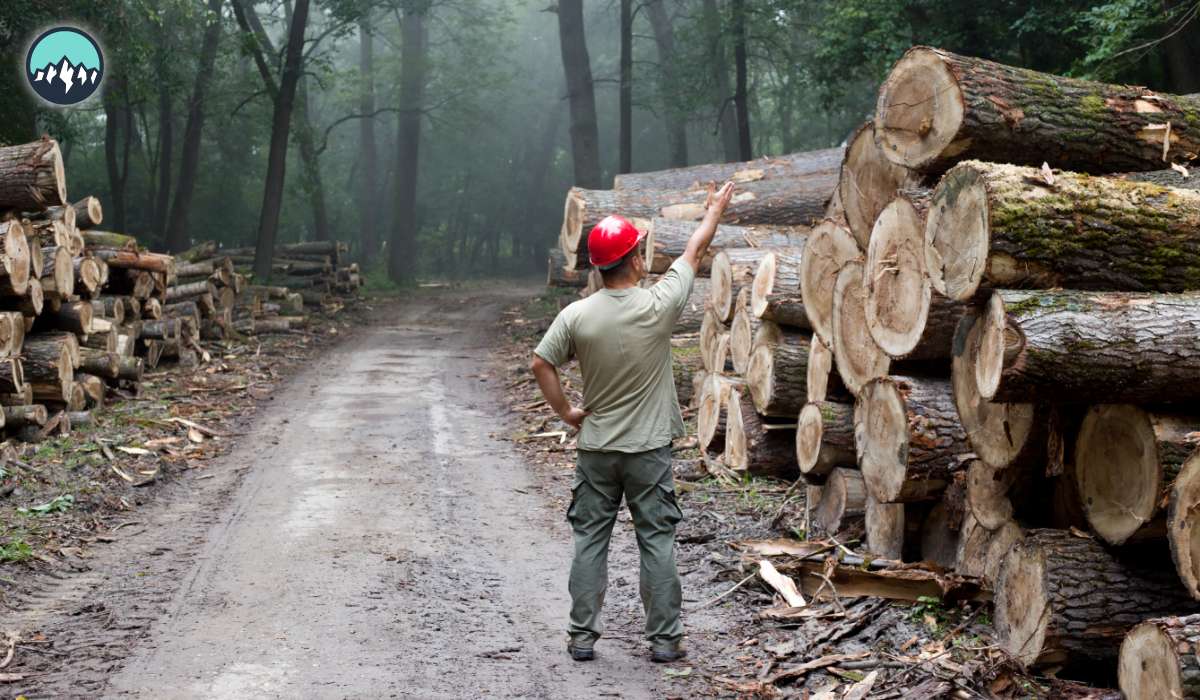Find a Job in Canada's Forestry Sector
04 Feb 2025

Canada's forestry sector presents many career opportunities for individuals at all experience levels. This strong industry plays a significant role in the Canadian economy, generating billions of dollars annually. Being able to go through Canada’s job market successfully requires a clear understanding of the industry and effective job-seeking strategies.
Looking for a career in Canada's forestry sector? Here are some valuable tips and resources to help you go through Canada’s job market and land your dream forestry job in Canada.
Canada's Forestry Sector

Canada's forestry sector is the lifeblood of its economy. It is worth approximately 105,3 billion CAD, according to the Forest Products Association of Canada.
Key Industry Sectors
The sector works through three main subsectors:
- Solid Wood Product Manufacturing: This segment makes softwood lumber and structural panels. It generates more than two-thirds of the sector's environmental technology contribution.
- Pulp and paper manufacturing: The segment creates everything from newsprint to household tissues.
- Forestry and logging: This segment handles field operations and timber harvesting. According to the Forest Products Association of Canada, it adds about 48,411 billion CAD to Canada's economy annually.
Major Canadian Employers
Companies like Canfor Corporation, West Fraser, and Resolute Forest Products have reshaped Canada's forestry sector scene. These Canadian employers run operations in over 300 forest-reliant communities, bringing economic stability to rural and remote areas.
Employment Statistics
The sector's workforce shows some notable patterns. The latest census from Statistics Canada reveals that 19% of forest sector workers are women, 13% are immigrants, 12% are visible minorities, and 6% are Indigenous people. The industry provides direct jobs to 212,660 Canadians, including more than 11,000 Indigenous people in different roles, according to Statistics Canada.
Each region has its employment patterns. According to Canada's Job Bank, British Columbia tops the list with 13,700 forestry and logging industry employees. The sector proves especially important in rural and Indigenous communities, where it is the primary income source.
Required Skills and Qualifications
Success in Canada's forestry sector depends on specific qualifications and skills that change across roles and provinces.
Educational Requirements
A bachelor's degree in forestry or forestry engineering is vital for professional forester positions. A two-year college diploma in forestry technology or renewable resources is enough for technical roles. Most Canadian provinces require professional registration with regulatory bodies. Manitoba and Prince Edward Island are the only exceptions. You must complete a two-year supervised work practicum and pass professional examinations before registration.
Technical Skills Needed
Forestry professionals need both hard and soft skills. Your technical toolkit should include:
- Computer proficiency with Geographic Information Systems (GIS) and GPS systems,
- Measurement tool operation,
- Sampling strategy implementation,
- Mathematical modeling abilities, and
- Data analysis capabilities.
Technical expertise alone won't be enough; you will also need strong communication and leadership skills. We focused on critical reasoning, problem-solving abilities, and shared decision-making skills. Physical stamina is a vital part of the job. You'll often walk long distances in heavily forested areas, tackle steep terrain, and face extreme weather conditions.
Safety Certifications
Safety is the lifeblood of forestry operations. Companies must maintain SAFE Certification, with requirements based on their size. Organizations with 20 or more workers need a BASE Basic Audit Safety Evaluation (BASE) audit. Smaller companies with 2-19 workers must get SEBASE or ISEBASE certification.
Individual workers should also get specific certifications. These include chainsaw safety, confined space entry, and WHMIS 2015 certification. Requirements vary by province, but these certifications ensure compliance with industry safety standards and protect workers and forest resources.
How to Secure a Job in the Forestry Sector?

Finding a job in Canada’s forestry industry requires strategy and persistence. Here are the steps to increase your chances of landing a role.
Step 1: Get the Right Education and Training
Most roles in the forestry sector require specialized knowledge. Start by obtaining a degree or diploma in forestry, environmental science, or a related field. Many colleges and universities in Canada offer programs designed to equip you with the necessary skills. For example, the University of British Columbia provides a well-regarded forestry program.
Gaining practical skills through internships, apprenticeships, or volunteer work can significantly boost your resume. Some roles also require certifications or licenses, such as a pesticide applicator’s certificate for specific forestry jobs.
Step 2: Tailor Your Resume to Forestry Jobs
When applying for positions in the forestry sector, ensure your resume highlights relevant skills and experience. Emphasize any previous work in natural resource management, environmental conservation, or outdoor work. If you have worked with machinery or have experience in logging or land surveying, mention it. Using keywords from the job description will also help your resume pass through applicant tracking systems (ATS), which many companies use to screen applications.
Step 3: Build a Network in the Forestry Industry
Professional networks are crucial when looking for forestry positions. The Canadian Institute of Forestry (CIF-IFC) has an active job board where Canadian employers post opportunities for forestry and natural resources professionals. Your relationships in the industry can open doors to promising careers.
Taking part in forestry-related associations gives you access to conferences, workshops, and networking events where you can meet potential Canadian employers. These connections often lead to mentorship opportunities and partnerships. Women in Wood offers specialized networking platforms with career advice and mentorship for women in the sector.
The Free to Grow in Forestry initiative supports gender equity through better recruitment strategies. Job seekers can benefit from the Outland Youth Employment Program's land-based training and industry connections. Professional social media and industry-specific online communities can be as effective as in-person networking. An active online presence can help potential employers notice you more easily.
Step 4: Search for Jobs on Industry-Specific Platforms
The forestry industry has several specialized job boards. The Greenest Workforce job board is a key resource that lists positions in forestry companies of all sizes. You can use this platform to compare living costs in different forestry communities and learn about current workers' experiences. Other notable job search platforms include:
- Canadian Forest Service (CFS) : for research and policy positions,
- ForestnetJobs.com: specializing in equipment operator and technical roles,
- Canadian-Forests.com: featuring positions from forest technicians to senior managers.
Industry Associations
Professional networks are vital when looking for forestry positions. The CIF-IFC has an active job board where employers post opportunities for forestry and natural resources professionals. Your relationships in the industry can open doors to promising careers.
Taking part in forestry-related associations gives you access to conferences, workshops, and networking events where you can meet potential employers. These connections often lead to mentorship opportunities and partnerships. Women in Wood offers specialized networking platforms with career advice and mentorship for women in the sector.
The Free to Grow in Forestry initiative supports gender equity through better recruitment strategies. Professional social media and industry-specific online communities can be as effective as in-person networking. An active online presence can help potential employers notice you more easily.
Step 5: Be Open to Relocation
The forestry industry is often concentrated in rural or remote areas, so being open to relocation can broaden your job opportunities. Many positions, such as those in forest management or logging, are located in provinces like British Columbia, Alberta, and Ontario, which are known for their extensive forests. Living in a remote area can be a rewarding experience. Still, ensuring you are comfortable with the lifestyle is essential before committing to a job in such a location.
Step 6: Prepare for Interviews
Once you have secured an interview, it’s time to prepare. Learn about the company’s values, projects, and recent developments in the forestry sector. Be ready to discuss your technical skills and how they relate to the specific forestry role you are applying for. Demonstrating knowledge of sustainable forestry practices and environmental policies can set you apart from other candidates. Showcasing your passion for the outdoors and conservation will help you make a positive impression.
Work Permit Requirements

Getting the right Canadian work permit opens doors to jobs in Canada's forestry sector.
Eligibility Criteria
Foreign nationals can choose between two Canadian work permit types for forestry careers. The first is an employer-specific work permit that needs a valid job offer and binds you to one Canadian employer. You need a Labor Market Impact Assessment (LMIA) from your future Canadian employer unless your position qualifies for an LMIA exemption.
The second option, an open work permit, gives you more freedom to work for any Canadian employer. These permits are only available in specific cases - like applying for permanent residence or being a skilled worker's spouse. You must prove these requirements to qualify for either permit:
- A valid passport and proof of qualifications,
- Sufficient funds to support yourself,
- Intention to leave Canada once your permit expires,
- Clean criminal record, and
- Good health status.
FAQs
Is it Necessary to be a Canadian Citizen to Work in the Forestry Sector?
No, being a Canadian citizen to work in the forestry sector is not strictly necessary. Still, you will need a valid Canadian work permit if you are a foreign worker. Many Canadian employers hire international workers, especially in remote areas, if the candidate has the required skills and qualifications. Ensure that you meet the specific immigration requirements for employment in Canada.
How Can I Gain Experience in the Forestry Field?
You can gain experience in the forestry field by applying for internships, volunteer opportunities, or apprenticeships with forestry companies or environmental organizations. Participating in field-based projects or research programs related to forest management can also help build hands-on experience. Obtaining relevant certifications or working on forestry-related tasks during your studies can enhance your Canadian resume.
Are There Any Financial Aid Options Available For Forestry Students?
Yes, various financial aid options are available for forestry students, including scholarships, grants, and loans. Many universities and forestry organizations offer specialized scholarships for students pursuing degrees in forestry or environmental sciences. Government programs and private institutions may support eligible students financially.




